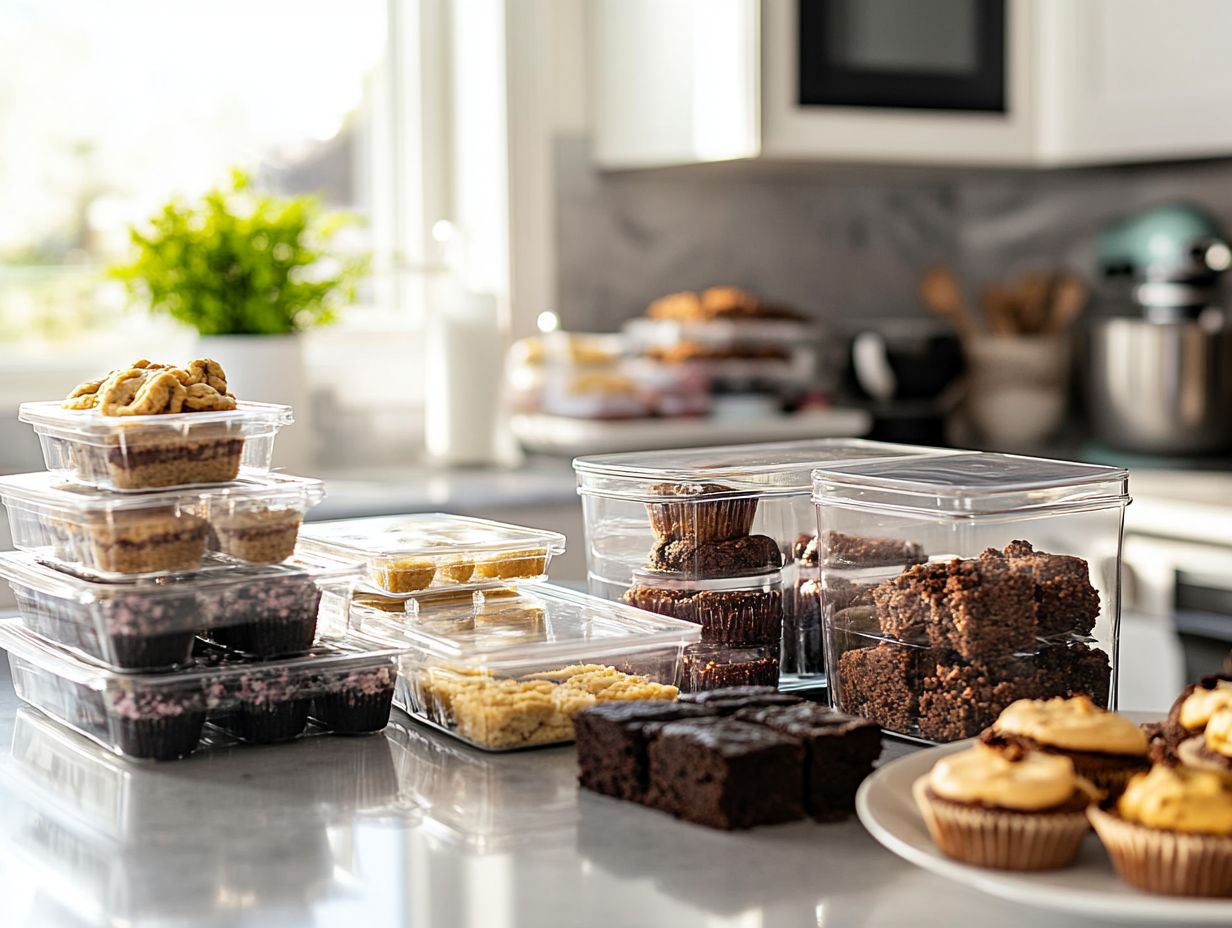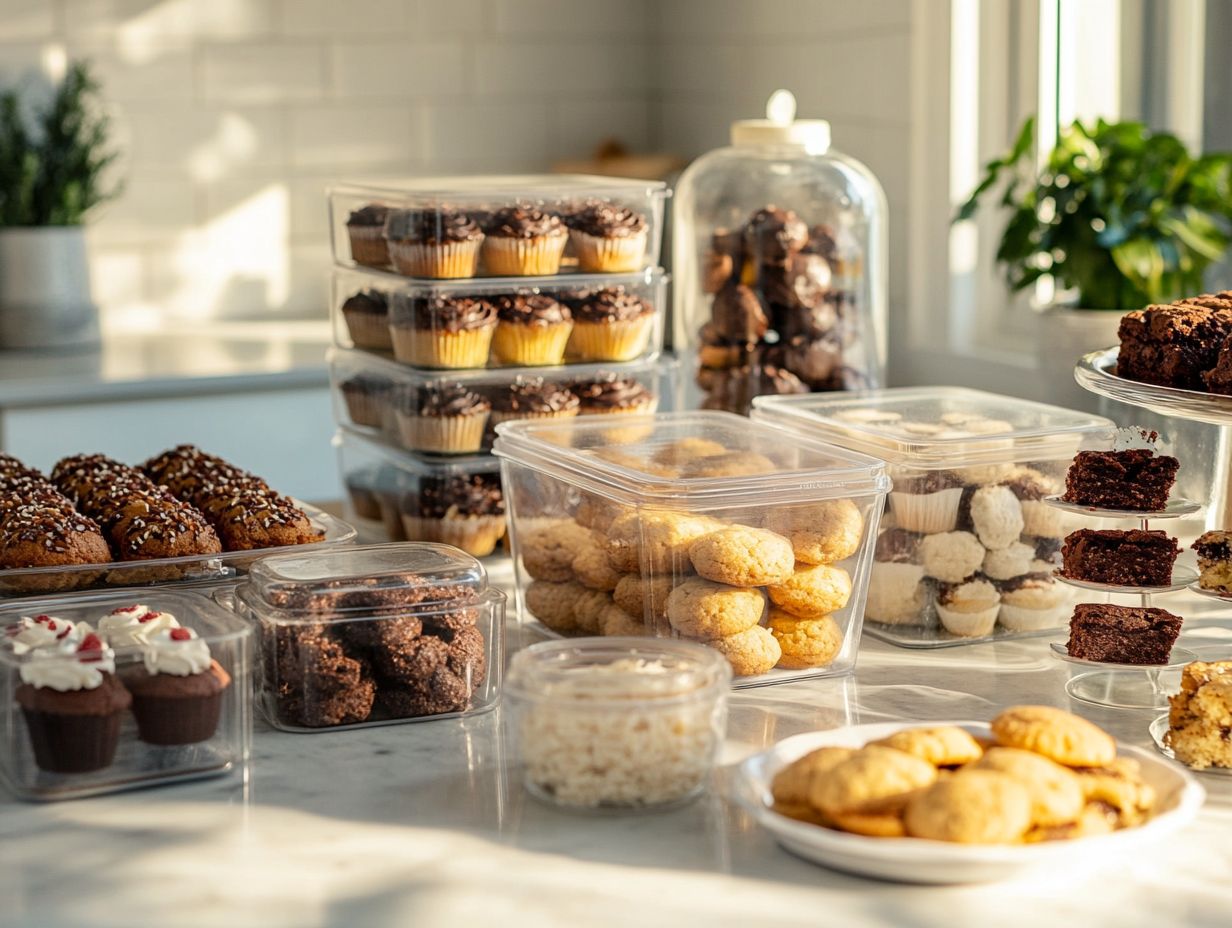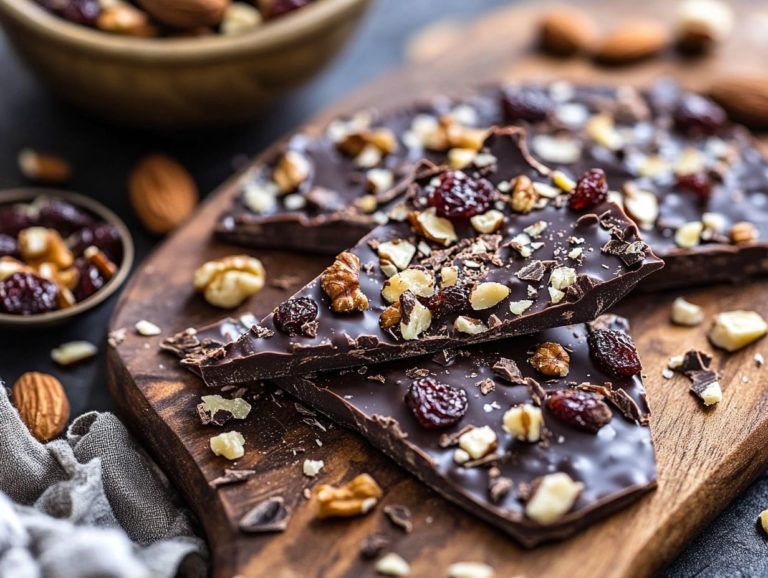How to Store Gluten-Free Desserts Properly
Gluten-free desserts have gained significant popularity. They provide delectable alternatives for individuals with gluten sensitivities, food allergies, or specific dietary restrictions.
To fully enjoy these gluten-free treats, proper food storage is essential to maintain their freshness and food safety.
Get ready to explore the exciting world of gluten-free desserts! This article delves into the realm of gluten-free desserts, examining what they are, the factors influencing their shelf life, and the most effective methods for storing them. You will also find useful baking tips and gluten-free recommendations to enhance your baking process.
Whether it s through refrigeration, freezing baked goods, or storing cake mixes, you ll find practical tips and key signs to look out for that can help prevent spoilage, ensuring your gluten-free sweets remain a delightful indulgence, bite after bite.
Contents
- Key Takeaways:
- What Is Gluten-Free Dessert?
- Why Is Proper Storage Important For Gluten-Free Desserts?
- What Factors Affect The Shelf Life Of Gluten-Free Desserts?
- What Are The Best Ways To Store Gluten-Free Desserts?
- How Long Can Gluten-Free Desserts Last In Different Storage Methods?
- 2. Freezing (1-2 Months)
- How To Properly Defrost Frozen Gluten-Free Desserts?
- What Are The Signs That Gluten-Free Desserts Have Gone Bad?
- How To Prevent Spoilage Of Gluten-Free Desserts?
- Frequently Asked Questions
- What is the best way to store gluten-free desserts?
- Can I freeze gluten-free desserts?
- How long will gluten-free desserts last in the fridge?
- Can I store gluten-free and regular desserts together?
- What is the best way to reheat frozen gluten-free desserts?
- How do I know if my gluten-free dessert has gone bad?
Key Takeaways:

- Proper storage is crucial for preserving the freshness and quality of gluten-free desserts and baked goods.
- Factors such as ingredients, storage temperature, packaging methods, and environmental conditions can affect the shelf life of gluten-free desserts.
- Refrigeration and freezing are the best ways to store gluten-free desserts and baked goods, with different time frames for each method.
What Is Gluten-Free Dessert?
Gluten-free desserts are exquisite sweet creations made without any gluten-containing ingredients, designed especially for those with gluten-related issues such as celiac disease and gluten sensitivity. They are an essential part of a gluten-free diet and cater to those managing health problems related to gluten consumption.
These delightful treats include a wide range of baked goods, from cookies, muffins, and cupcakes to cakes and pastries, all crafted using various gluten-free flours like rice, tapioca, potato flour, almond flour, and coconut flour.
The gluten-free market has flourished, offering you a remarkable selection of alternatives to traditional sweets, ensuring that you can savor every bite without compromising your health. As awareness of gluten-free living continues to rise, the array of gluten-free recipes expands, allowing you to indulge in sumptuous delights without the worry of any adverse health effects.
Why Is Proper Storage Important For Gluten-Free Desserts?
Proper storage of gluten-free desserts is essential for preserving their quality and ensuring food safety, which directly influences food freshness and consumer satisfaction. With the gluten-free market on the rise and more consumers seeking gluten-free options, understanding the importance of effective food storage practices is vital.
This knowledge helps prevent mixing with gluten-containing foods and maintains the integrity of gluten-free products. Given the health concerns associated with celiac disease and gluten sensitivity, it’s crucial to prioritize meticulous kitchen hygiene and appropriate food storage methods to protect against gluten particles that could jeopardize health.
By implementing recommended storage techniques, you can extend the shelf life of your gluten-free treats while ensuring they remain a delightful indulgence.
What Factors Affect The Shelf Life Of Gluten-Free Desserts?
The shelf life of your gluten-free desserts is influenced by several critical factors, including the ingredients you choose, the storage temperature, and the packaging methods employed. Each of these elements plays a pivotal role in determining how long your creations will last.
Regarding gluten-free baking, you may encounter unique challenges due to the distinct properties of gluten-free flours and ingredients, which can vary significantly in moisture control and stability compared to traditional flours. It s also essential to understand how different ingredients, such as gluten-free mixes and flours, interact with one another during the baking process. This knowledge can help you craft desserts that stay fresh for longer.
Paying careful attention to your storage practices and environmental conditions is vital for preserving the quality of your gluten-free baked goods.
Finally, we invite you to try out gluten-free recipes and share your experiences with us!
1. Ingredients Used
The ingredients you choose for gluten-free desserts are crucial in shaping not just the taste and texture, but also the overall shelf life of your final creation.
With a wide selection of gluten-free flours at your disposal think almond, coconut, and brown rice flour you have an impressive range of options that significantly influence the outcome. Each flour brings its own unique qualities to the table: almond flour introduces a delightful nuttiness. Coconut flour offers a light, airy texture that can elevate your desserts.
When exploring gluten-free mixes, pay attention to how the ingredients interact. A well-balanced combination of starches and proteins can enhance the moisture retention and freshness of your baked goods. Conversely, pairing the wrong ingredients might lead to dry or crumbly results. Understanding these intricate details enables you to experiment confidently, resulting in delectable treats that stand the test of time.
2. Storage Temperature
Storage temperature plays a pivotal role in maintaining the freshness and longevity of your gluten-free desserts, making it essential to create the best ways to keep them fresh.
When you apply the right refrigeration or freezing techniques, you can significantly enhance the quality of those delectable treats. For example, refrigeration effectively slows down the growth of spoilage microorganisms, allowing your cookies and cakes to stay delicious for an extended period. Freezing takes it a step further, prolonging shelf life while preserving not just the texture but also the rich flavors of these indulgent snacks.
By understanding these temperature dynamics, you can plan your storage effectively, ensuring that the delightful experience of your gluten-free desserts is preserved from the moment they are crafted until they are savored.
3. Packaging

The packaging of gluten-free products plays a pivotal role in preserving their quality by effectively controlling moisture and preventing spoilage.
To extend the shelf life of your gluten-free desserts, it s vital to use airtight containers and proper sealing techniques. These practices protect your baked goods from humidity and air exposure, which are the main offenders in ruining taste and texture. Techniques like vacuum sealing a method that removes air from packaging to keep food fresh or using resealable bags can significantly boost the freshness of your gluten-free items. Incorporating desiccant packets can absorb any excess moisture, providing an extra layer of protection for your products.
By embracing these packaging strategies, you can ensure that the delicate flavors and characteristics of your gluten-free desserts remain intact for an extended period, allowing each bite to excite your taste buds.
What Are The Best Ways To Store Gluten-Free Desserts?
Storing gluten-free desserts properly is vital for maintaining their quality and flavor over time. The best practices can vary depending on the type of dessert and how long you plan to keep it.
Understanding the nuances of refrigeration, freezing, and room temperature storage is crucial for you as a gluten-free consumer who wants to relish those baked goods at their freshest. Employing proper food storage techniques not only prevents spoilage but also elevates your overall eating experience by ensuring that your gluten-free treats remain delicious and safe.
By adhering to recommended storage practices, you can effectively manage your gluten-free pantry, minimize food waste, and extend the enjoyment of your favorite desserts. These practices are crucial for gluten-free consumers who aim to maintain the freshness and safety of their gluten-free products.
Try out these storage tips, and share your own experiences with gluten-free desserts!
How Long Can Gluten-Free Desserts Last In Different Storage Methods?
The longevity of gluten-free desserts can vary greatly depending on how you store them, directly affecting their shelf life and overall quality. Understanding how long gluten-free products can last when refrigerated, frozen, or kept at room temperature is essential for maximizing your enjoyment and minimizing waste.
For example, refrigerated gluten-free treats typically last 1-2 days, while freezing them can extend their lifespan to an impressive 1-2 months. Storing at room temperature usually allows for just 1-2 days, so careful planning is necessary for those on a gluten-free diet.
These distinctions are vital for anyone navigating the world of gluten-free options, ensuring you have delicious and safe treats ready to enjoy.
1. Refrigeration
Refrigeration is one of the most effective methods for storing gluten-free desserts like cookies and cakes, ensuring their freshness remains intact.
By keeping these mouth-watering treats at cooler temperatures, typically between 35 and 40 degrees Fahrenheit, you can significantly extend their shelf life while preserving both their texture and flavor. For instance, gluten-free cookies can last up to a week in the fridge, while gluten-free cakes are best enjoyed within 5 to 7 days to guarantee the best taste. This approach is especially beneficial for treats containing dairy foods or fruit, which tend to spoil more quickly.
You can store some frozen gluten-free desserts for months, offering a convenient solution for those spontaneous dessert cravings, all without compromising on quality.
2. Freezing
Freezing gluten-free desserts is an excellent way to extend their shelf life while preserving their delightful flavors. This method is a favorite among people who eat gluten-free and those following a gluten-free lifestyle.
This method not only helps with portion sizes but also allows you to enjoy homemade treats whenever the occasion calls for it. To ensure that these irresistible creations maintain their taste and texture in the freezer, it s essential to package them carefully. Using airtight containers or heavy-duty freezer bags can greatly reduce the risk of ice damage.
When you re ready to indulge in your frozen desserts, let them thaw slowly in the refrigerator. This gentle defrosting method helps retain moisture, preventing them from turning soggy. By following these simple yet effective tips, you can savor your gluten-free masterpieces just as deliciously as they were meant to be enjoyed.
3. Room Temperature
Storing gluten-free desserts at room temperature can be suitable for short-term indulgence, especially for items like gluten-free muffins and cookies.
It s crucial to keep these delightful treats in a cool, dry spot, away from direct sunlight, as exposure can lead to unwanted moisture and spoilage. Ideally, you should aim to enjoy them within 2-3 days to fully appreciate their flavor and texture.
Using airtight containers can significantly help maintain their freshness, and it s equally important to keep them away from strong odors, as gluten-free baked goods can easily absorb flavors from their surroundings.
If you re planning to enjoy these desserts for longer than a few days, consider using proper refrigeration or freezing methods to maintain their quality.
1. Refrigeration (1-2 Days)

Gluten-free desserts stored in your refrigerator typically last between 1 to 2 days, so it s essential to indulge in them within this timeframe for optimal freshness.
Certain gluten-free treats, like mousse, puddings, and cheesecake, tend to maintain their texture and flavor better when kept chilled. Remember, the ingredients you choose significantly influence their shelf life; desserts made with dairy foods may spoil more quickly than their dairy-free counterparts.
The presence of fresh fruits can complicate matters, as they can degrade quickly, impacting both taste and overall quality. To maximize the longevity of these delightful creations, consider implementing smart packaging and proper sealing techniques. This way, each bite remains as delectable as the first, allowing you to enjoy your gluten-free indulgences for as long as possible.
Have you tried these storage methods for your gluten-free desserts? Share your experiences and tips below!
2. Freezing (1-2 Months)
When frozen correctly, gluten-free desserts can last 1 to 2 months. This significantly extends their shelf life compared to simply refrigerating them.
To ensure these delightful treats retain their flavor and texture during the freezing process, follow some key best practices. Start by allowing your desserts to cool completely; any lingering warmth can encourage ice crystals, altering their texture.
When it s time to package them, choose sealed containers or heavy-duty freezer bags to guard against freezer burn. It’s also a smart move to label each package with the date and contents for easy tracking of freshness.
Consider portioning out servings before freezing so you can effortlessly thaw just what you need for a quick indulgence later on.
3. Room Temperature (1-2 Days)
Enjoy gluten-free desserts kept at room temperature within 1-2 days to maintain their quality and flavor.
Many types of gluten-free treats are designed to endure this window beautifully. Indulge in options like brownies, flourless chocolate cakes, and certain cookies, as their dense textures resist drying out effectively.
Keep your treats fresh by storing them in a sealed container, away from direct sunlight or heat sources. For an extra tip, consider adding a slice of apple or a piece of bread in the container; it can help absorb excess moisture and keep those desserts deliciously moist longer.
How To Properly Defrost Frozen Gluten-Free Desserts?
Properly defrosting frozen gluten-free desserts is crucial for preserving their delightful texture and flavor. This ensures they remain enjoyable after storage.
To achieve the best results, transfer those treats from the freezer to the refrigerator and let them thaw slowly overnight. This gradual defrosting method helps maintain moisture levels and prevents ice crystals from forming, which can compromise quality.
If you’re in a hurry, use the microwave’s defrost function as a quicker alternative. However, proceed with caution to avoid overheating, which could jeopardize the delicate nature of gluten-free ingredients. Also, avoid the temptation to refreeze your desserts after thawing, as this can further diminish their texture and flavor.
What Are The Signs That Gluten-Free Desserts Have Gone Bad?
Recognizing signs that gluten-free desserts have gone bad is essential for maintaining food safety and avoiding health issues.
Watch for visual indicators like discoloration, mold, or ingredient separation, as these clearly signal spoilage. An off-putting or sour smell is another warning sign that the dessert is no longer safe for enjoyment.
Texture changes are equally important; if your dessert feels unusually dry, crumbles easily, or becomes excessively sticky, it s likely past its prime.
By adhering to proper food storage practices like keeping your treats in sealed containers and storing them in cool, dry places you can extend the freshness of these delightful desserts and ensure they remain safe for enjoyment.
How To Prevent Spoilage Of Gluten-Free Desserts?
To prevent spoilage of gluten-free desserts and maintain their quality, effective food storage practices are essential for anyone committed to a gluten-free lifestyle.
Proper storage techniques extend the longevity of these delightful treats and ensure their rich flavors and appealing textures remain intact. Choosing the right containers is crucial; sealed options minimize exposure to air and moisture, the primary culprits behind spoilage.
Utilizing vacuum-sealed bags can be a transformative strategy for longer storage periods. Opting for high-quality, shelf-stable options like almond flour or coconut sugar enhances the overall durability of your desserts.
Refrigerating or freezing these sweet creations significantly slows down spoilage, allowing you to savor them over time without compromising on taste or freshness.
Frequently Asked Questions

What is the best way to store gluten-free desserts?
The best way to store gluten-free desserts is to keep them in an airtight container or wrapped tightly in plastic wrap. This will prevent air and moisture from getting to the dessert, which can cause it to dry out or become stale.
Can I freeze gluten-free desserts?
Yes, gluten-free desserts can be frozen. Make sure to wrap them tightly in plastic wrap or place them in an airtight container before freezing. Thaw them in the refrigerator before serving.
How long will gluten-free desserts last in the fridge?
Gluten-free desserts can last in the fridge for 3-4 days. Make sure to keep them in an airtight container to prevent them from drying out.
Can I store gluten-free and regular desserts together?
No, it is not recommended to store gluten-free and regular desserts together. This can cause cross-contamination and make the gluten-free dessert unsafe to eat for those with Celiac disease or gluten intolerance.
What is the best way to reheat frozen gluten-free desserts?
The best way to reheat frozen gluten-free desserts is to let them thaw in the fridge overnight and then warm them in the oven at a low temperature. This will prevent the dessert from becoming rubbery or dry.
How do I know if my gluten-free dessert has gone bad?
If your gluten-free dessert has become dry, hard, or has a strange smell, it may have gone bad. It is always best to err on the side of caution and discard the dessert if you are unsure.






